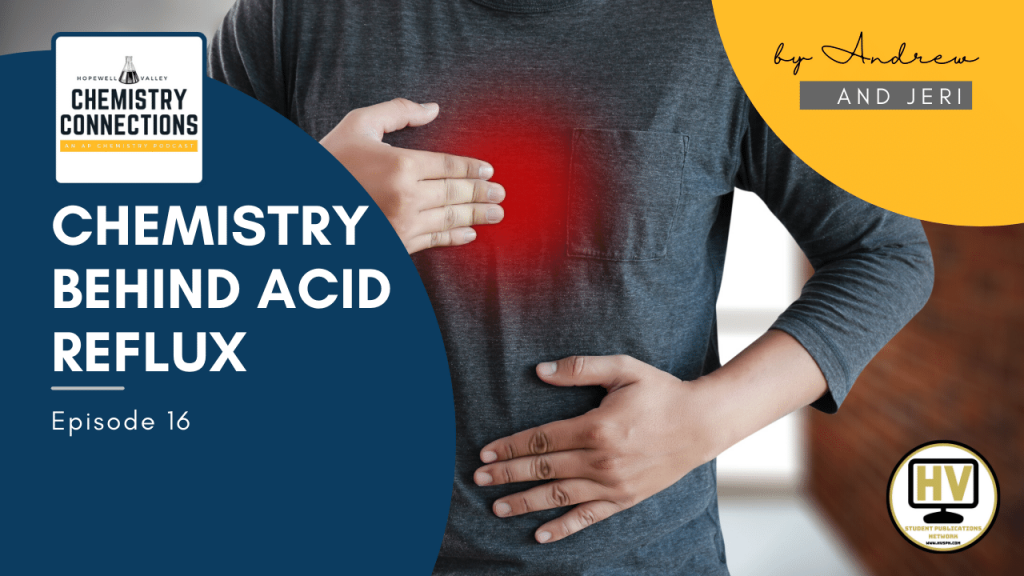Chemistry of Acid Reflux

Hopewell Valley Student Podcasting Network
Chemistry Connections
The Chemistry Behind Acid Reflux
Episode #16
Welcome to episode #16 of Chemistry Connections. We’re your hosts, Jeri Nestle and Andrew McManimon. In today’s episode, “The Chemistry Behind Acid Reflux,” we’ll be discussing Acid Reflux: what causes it, how it can be treated, and the chemistry behind it all.
Segment 1: Introduction to Acid Reflux
We’ll start with the definition of acid reflux…
- So, what is acid reflux?
- commonly called gastroesophageal reflux disease or simply GERD
- some background about the condition: is defined as the occurrence when stomach acid comes back up into the esophagus.
- symptoms of GERD include heartburn, burning chest pains, and nausea (room for question- Why does it cause heartburn specifically?)
- important to make the distinction between acid reflux and GERD- while technically the bodily process that occurs is the same thing, acid reflux is itself temporary, while GERD is chronic.
- mechanics of reflux: the lower esophageal sphincter is a ring-shaped muscle that separates the stomach from the esophagus (clarify: multiple sphincters throughout the body)
- the job of the sphincter is to keep food down from the food pipe into the stomach, but in acid reflux, the sphincter doesn’t close completely and gastric acid can come back up into the food pipe
- It’s interesting because we know what can cause acid reflux, but we don’t know why people develop GERD chronically
Segment 2: The Chemistry Behind Acid Reflux
- Acid reflux chemistry
- This stomach acid, which is also called gastric acid, is mainly composed of HCl, and also contains KCl and NaHCl. It is highly acidic, with a pH between 1-2. For listeners who may not be familiar with the pH scale, it is BASED on a scale of 1-14 with pH values of 1-6 being labeled as “acidic” and those with a pH value of 8-14 being considered “alkaline.” 7 is a neutral baseline, in which acidic and alkaline, or basic, substances are compared. A common example of a neutral substance is pure water.
- Weird that something so corrosive helps us live, but stomach acid provides a crucial key in our digestive process
- because it is highly corrosive, it helps break down the food and substances we consume so our body can further break it down and take what we need from it, like vitamins and minerals. More specifically, it works to denature any consumed protein by decomposing its globular structure into amino acid chains. The low pH value also creates the perfect condition for enzymes in the stomach to function. One of the main types of enzymes in the stomach is called proteases, which work to break the amino acid chains into shorter chains, explaining globular amino acid things or individual amino acids to make digestion easier. These enzymes can only work at a low pH, so it is important to maintain this acidic environment.
- Jeri recap in human terms
- Human stomachs can contain stomach acid because the stomach lining is resistant to corrosion thanks to the mucus it secretes, but the lining of the esophagus is not. Acid reflux can usually be treated with an antacid, like Alka Seltzer.
- How antacids work to neutralize the HCl in gastric acid
- Antacids like Alka Seltzer, are doses of mild bases that react with the excess HCl in acid-base neutralization reactions to neutralize the acidity of the gastric acid, returning the body back to normal conditions
- Ex. Calcium carbonate (CaCO3) is an active ingredient found in Tums that neutralizes HCl
- The acid-base reaction converts carbonic acid into CO2 into H2O
- CaCO3 (s) + 2HCl (aq) → CaCl2 (calcium chloride) (aq) + H2O (l) + CO2 (g)
- MgCO3 and NaHCO3 are also common substances used to neutralize the stomach acid
Segment 3: Personal Connections
- Jeri, personal connection
- has some LPR laryngopharyngeal reflux – acid reflux into the larynx/throat
- a lot of people have this, but don’t notice it because it’s considered “silent” acid reflux
- mostly people who sing/speak a lot and publicly notice it
- was interested in the chemistry behind acid reflux
- a lot of conflicting info online about home remedies and how to combat acid with acidic or alkaline foods/ingredients
- Some home remedies include consuming highly acidic substances
Thank you for listening to this episode of Chemistry Connections. For more student-ran podcasts and digital content, make sure that you visit www.hvspn.com.
Sources:
List your sources here. Make sure they are linked. Wikipedia cannot count for more than 50% of your sources.
https://sciencedebate.com/science-blog/acid-reflux-what-it
https://www.medicalnewstoday.com/articles/322879
Music Credits
Warm Nights by @LakeyInspired
Subscribe to our Podcast
Connect with us on Social Media
Welcome to episode #16 of Chemistry Connections where we’ll be discussing Acid Reflux causes, treatments and the chemistry behind it all.

